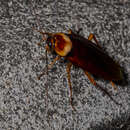Comprehensive Description
provided by Memoirs of the American Entomological Society
Periplaneta americana (Linnaeus) (Plate VII, figures 3 to 11.)
1758. [Blatta] americana Linnaeus, Syst. Nat., Ed. X, p. 424. [America.]
1773. Blatta kakkerlac DeGeer, Mem. I'Hist. Ins., iii, p. 535, pi. 44, figs, i, 2 (cf),
3 (9). [Meridional South America, [Surinam].] 1901. Periplaneta americana colorata Rehn, Trans. Am. Ent. Soc, x.vii, p. 220.
[ 9 (nee cT), Cuernavaca, Morelos, Mexico.]
DeGeer admittedly gave the name kakkerlac to the species described by Linnaeus as americana. Shelford has shown-^^ that the types of americana and other species collected by Rolander and described by Linnaeus, probably belonged to DeGeer, and were subsequently again described by that author. Thus we may safely assume that, though Linnaeus' description of americana is extremely unsatisfactory, the characters described and shown in the figures of the synonymous kakkerlac by DeGeer, fix the species' identity beyond doubt.
The specimen described as americana colorata by Rehn, is before us. It is clearly a mere color variant, with marginal caudal band of pronotum as normal in P. brunnea, and is not worthy of name recognition.
The established synonyms of the present species are Blatta kakkerlac DeGeer, Blatta aurelianensis Fourcr., Blatta siccijolia and aiirantiaca StoU, Periplaneta stolida Walker and Periplaneta americana variety colorata Rehn.
This is a large, shining, reddish brown insect, with paler pronotum showing two large, but weakly defined, spots meso-cephalad and a marginal suffusion caudad of the general darker coloration. It is the largest of the North American species of the genus, having the most decidedly caudate organs of flight, agreeing rather closely in coloration with brunnea, but normally with pronotum showing the paired meso-cephalic blotches more decided and the marginal caudal l)and and lateral suffusion less intense. In l^oth species,
-**^ Trans. Ent. Soc. London, 1907, p. 456, (1908). however, decided color variation occurs and occasionally size variation makes it necessary to examine material carefully before definitely correct determinations can be given for females. The two other North American species of the genus, aiistralasiae and Jidiginosa, show distinctive features, not only of structure, but of coloration as well.
Characters of Male. — (Yuma, Arizona.) Size large, form stout. Head elongate;-^" interocular space narrow, less than one millimeter in width, interocellar area forming an obtuse angle with ocellar areas; ocelli pale and distinct. Pronotum weakly convex, the convexity more decided narrowly laterad, disk with broad but shallow oblique sulci; margin above head transverse, thence lateral margins are divergent and weakly convex to slightly beyond mesal point, thence weakly convergent and convex to caudal angles, caudal margin broadly convex; all angles very broadly rounded. Tegmina and wings elongate and fully developed. Dorsal surface of abdomen unspecialized, with latero-caudal angles not produced and bluntly rounded.
- bibliographic citation
- Hebard, M. 1917. The Blattidae of North America. Memoirs of the American Entomological Society vol. 2. Philadelphia, USA
Comprehensive Description
provided by Memoirs of the American Entomological Society
Periplaneta americana (Linnaeus)
1758. [Blatta] americana Linnaeus, Syst. Nat., Ed. X, |). 424. [America.] 3 to II. (Detailed diagnosis.)
Gatun, Canal Zone, Panama, VII, 28 to 'III, 22, 1916, (Harrower), 30^, 3 9,
1 juv.
Balboa, C. Z., Pan., 1, 8, 1916, (Harrower), i cf .
This and the following three species are domiciliary insects, widely distributed through tropical America.
- bibliographic citation
- Hebard, M. 1919. The Blattidae of Panama. Memoirs of the American Entomological Society vol. 4. Philadelphia, USA
Comprehensive Description
provided by Memoirs of the American Entomological Society
Periplaneta americana (Linnaeus)
1758. Blatta] americana Linnaeus, Syst. Nat., Ed. X, p. 424. [America.]
This species is fully discussed on page 178.
Pequaming, Michigan, M, 30, 1903, (Hehard; in store), i juv., [Hebard Cln.]. Milwaukee, Wisconsin, IX, 10, 1912, (A. C. Burrill), I cf', [Wise. Agr. Exp. Sta. Cln.].
- bibliographic citation
- Hebard, M. 1917. The Blattidae of North America. Memoirs of the American Entomological Society vol. 2. Philadelphia, USA

